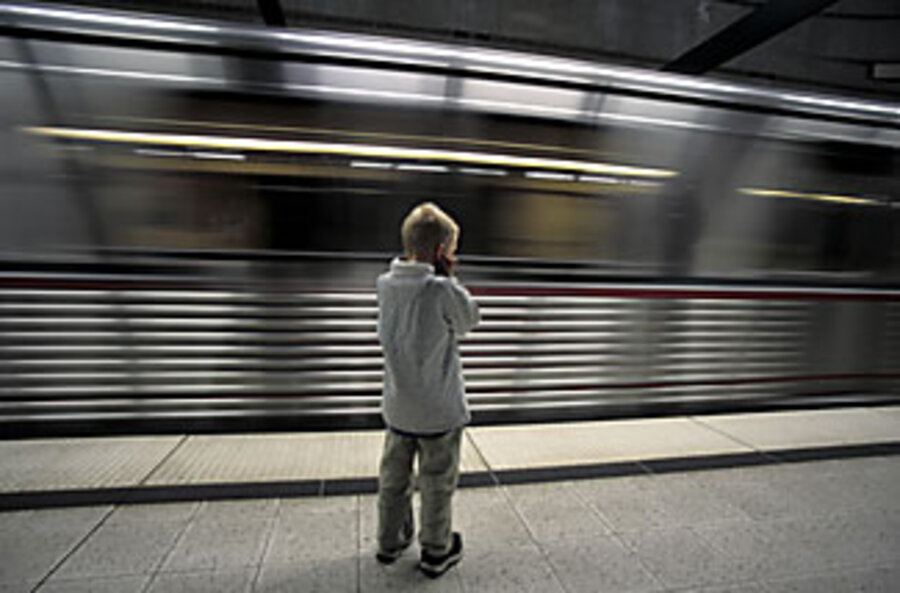Free-range kids
Loading...
| Los Angeles
When applied to poultry, the term "free range" evokes images of chickens running freely in wide-open spaces. When used to describe human offspring, the moniker "free-range kids" is intended to conjure up the same sort of unencumbered wandering with few boundaries.
For New York Sun columnist Lenore Skenazy, who coined the term in April, the idea blossomed after her decision to allow her 9-year-old son to ride the New York public transportation system – subway and crosstown bus – from Bloomingdale's in midtown Manhattan to her home just off 34th Street.
The humor writer penned a column regaling readers with her son's triumphant foray into independent urban living and was stunned to find herself at the center of a firestorm of controversy. Many people called her a threat to her child's safety. But, she says, more readers wrote in support of her desire to teach her child to be self-sufficient, so she and her husband decided to found a website (http://freerangekids.wordpress.com) to further the emerging dialogue.
In the weeks that have ensued, it is clear that Ms. Skenazy and her family have touched a nerve in the national psyche, say educators, medical professionals, and sociologists. For a complicated mix of reasons, including the high cost of gasoline, America's slipping position of global leadership, and unprecedented levels of stress on the American family in a 24/7 culture, these observers see an urgent and growing desire among families to reassess their lifestyles.
More balanced parenting
Many say the much-written-about "helicopter" or hovering parents of recent years need to give way to a more balanced form of parenting, one that allows for more independence and risk-taking.
"We used to see the notion of a 'vulnerable child' only in medical terms," says Dr. Robert Coleman of the American Academy of Pediatrics. The term meant that a child might be at risk for specific physical reasons but was otherwise considered "safe." However, in the past four decades, that definition has expanded, leading to what he calls an "epidemic of seeing all children as vulnerable, all the time."
Beyond the obvious stress that this constant state of anxiety induces in both parents and children, a generation of kids raised without learning to handle or even face risks won't be prepared to take leadership positions in business or civic life, experts note. "We have begun to lose sight of the notion of comparative risk," says Richard Louv, author of "Last Child in the Woods: Saving Our Children from Nature-Deficit Disorder."
"We are dangerously close to becoming a society that is so risk-averse that we drain the lake because one child drowns." This attitude actually puts the larger society at risk because, says Mr. Louv, extending the metaphor, with no lake, no child would learn to swim.
Businesses have already begun to identify this as a serious problem, says consultant and Washington-based speaker Silvana Clark. For example, in initial job interviews, the tech giant Microsoft will often ask applicants to describe a risk they took in a previous job and how they handled the consequences.
"More and more companies are finding young job seekers simply don't have this skill set," says Ms. Clark. Innovation requires risk, she adds, and for American business to retain a leadership position, risk must be reintegrated into child-raising.
Many parents want to change their ways but feel trapped by fears about safety and keeping up, says Bob Livingstone, a clinical social worker in San Mateo, Calif. "They feel bombarded by our 24/7 culture, where the media have a field day with every incident involving a child, and they worry constantly about getting their kids into the best schools...."
But a quick look at actual statistics on child abductions reveals that the number of abductions by strangers has remained steady at under 200 for decades. That stands in stark contrast to the level of fear and worry about the safety of minors that Mr. Livingstone says he sees in his family practice.
Change isn't as simple as merely allowing a child to walk unescorted to a friend's house. Real progress will come only when fundamental attitudes begin to change, says Louv, who is a passionate advocate for the role of nature in a child's education.
The natural world is the best environment to challenge and develop a child's innate abilities, he says. "Two-dimensional environments like television and video games do not provide the spontaneous stimulation that nature does." He points to pending legislation in Congress dubbed "No Child Left Inside," as evidence that this view is gaining momentum.
An ongoing dialogue
In fact, although Skenazy came up with the term, "free-range kids" as she and her husband contemplated children raised with "no cages," the free-range notion of child-raising has circulated among thinkers at least since Britain's progressive educational experimentation at Summerhill in the 1920s.
Skenazy says her website and nascent movement are moving forward with an ongoing dialogue about just what free-range kids should act like. On her website, she freely fields comments and letters from all points on the spectrum, but has gone to great pains to explain that she is not reckless.
She believes in bicycle helmets, air bags, and car seats. The message she wants to get out is fairly simple: "The world is nowhere near as dangerous as the media would have us believe and maybe not as safe as some would like it to be." But, she adds, "How will our kids ever learn that if we don't let them out until they're 21?"





